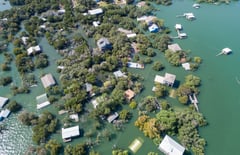Builder to Buyer Flood Risk Education
 An astonishing 98 percent of U.S. counties have been impacted by a flood event, according to the Federal Emergency Management Agency (FEMA) and floods are the number one natural disaster in the United States. Moreover, the increasing weather risks associated with global climate change means that homebuyers should consider flood insurance, even if they don’t live in a floodplain.
An astonishing 98 percent of U.S. counties have been impacted by a flood event, according to the Federal Emergency Management Agency (FEMA) and floods are the number one natural disaster in the United States. Moreover, the increasing weather risks associated with global climate change means that homebuyers should consider flood insurance, even if they don’t live in a floodplain.
Homebuilders and real estate professionals can help their customers protect their biggest asset by understanding the risks and educating their buyers. Here are five facts about flooding and flood insurance that the builders should know and educate buyers about.
Fact #1: Flood Hazard Areas Change
Because new construction can change the flood hazard potential of an area, affecting how water flows and drains from land, flood maps change to reflect risk conditions. FEMA uses the latest technology to develop flood maps to help communities, property owners, businesses, and stakeholders take steps to address flood risks. To find out your community’s preliminary flood hazard, search the FEMA preliminary flood data search tool.
Fact #2: It Doesn’t Have to Rain to Flood
Most people think that rainwater drainage is their only concern when it comes to a flood, but floods can happen anytime land is inundated by water, which can cause runoff of surface waters, mudflow or even backed-up storm drains.
Fact #3: Flood Insurance Cost Average $700 Annually, Average Claim $43,000
According to Insurance.com, the average National Flood Insurance Program (NFIP) policy costs $700 per year, but homeowners will pay much less (about $150) if they live in an area with a low-to-moderate flood risk. Some buyers may believe that home insurance covers flood damage and be shocked to find out that expensive repairs needed following a flood event aren’t covered. Mortgage lenders will require homes in risky flood areas to have insurance, but not those homes in low-to-moderate risk areas. Yet, one-quarter of flood-related claims come from low-to-moderate flood areas, according to Insurance.com.
Flood coverage would cover such things as structural damage to drywall, insulation that’s been submerged in water and needs to be replaced, as well as carpeting or flooring.
Fact #4: There’s a 30-Day Waiting Period… Except with New Mortgages
When a buyer purchases flood insurance, there’s normally a 30-day waiting period[1] for the insurance to become effective, but some policies can start sooner. For example, if the buyer is purchasing flood insurance in connection with making, increasing, extending, or renewing a mortgage loan, there is no waiting period.
Fact #5: Buyers Can Research Flood Risk and Costs
FEMA has a cool data visualization tool that shows the historical flood risks for each state using data compiled by the National Oceanic and Atmospheric Administration (NOAA). Note: the information on costs is averaged, so the homeowner’s costs may vary depending on many factors, including risk of flooding, creditworthiness, and their claims filing history.
Key Takeaways
Major flooding incidents in the U.S. are becoming more likely in the face of climate change. In 2018, flooding events resulted in nearly $124 billion in losses.[2] Since flooding is the number one natural disaster impacting homeowners, given the increasing risks, homebuyers should consider flood insurance and speak to their insurance agent about options and premiums, even if they don’t live in an area at high risk for flooding.
[1] https://www.fema.gov/news-release/2018/05/01/dont-wait-buy-flood-insurance-today
[2] https://www.climate.gov/news-features/blogs/beyond-data/2018s-billion-dollar-disasters-context





